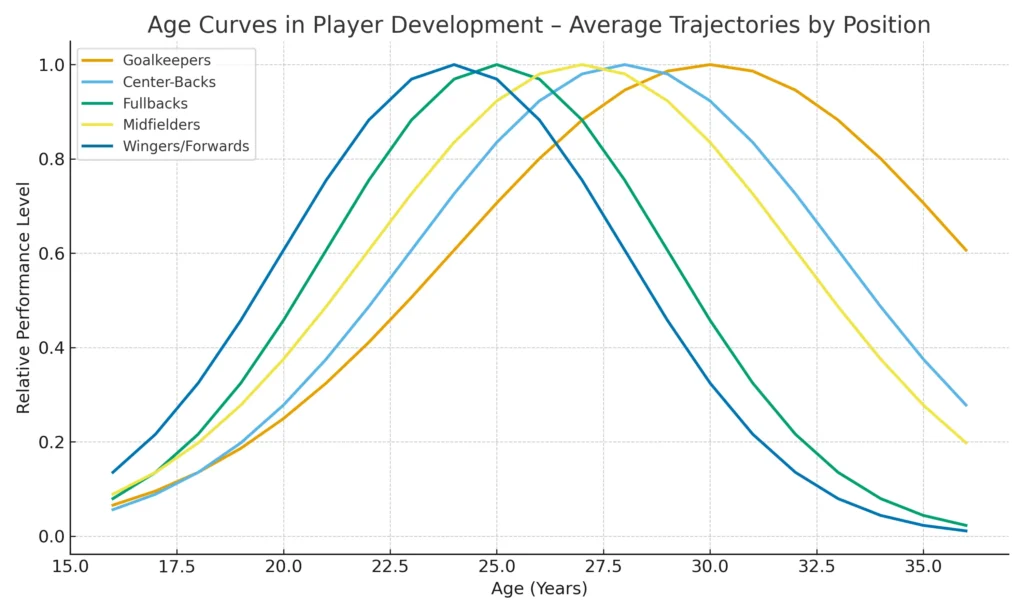One of the most critical tasks for coaches, scouts, and analysts is predicting how a player will evolve over time. Player recruitment and development hinge not only on evaluating current ability but also on projecting future performance. This is where age curves become invaluable.
An age curve is a model that represents how a player’s performance typically develops across their career, from early breakthrough years to peak performance and eventual decline. Understanding these trajectories helps professionals make informed decisions:
- Scouts can identify whether a promising teenager is on track to reach senior-level potential.
- Coaches can adjust training loads and expectations based on a player’s developmental stage.
- Clubs can optimize contract management and squad planning by anticipating peaks and declines.
But age curves are not universal — they differ by position, playing style, and even by league. This article breaks down the nuances, providing an applied framework for those working inside the game.
Theoretical Foundations of Age Curves
The concept of age curves originates from both sports science and performance analytics. In simple terms, most physical attributes follow biological patterns of growth and decline:
- Explosive speed and acceleration tend to peak earlier, often between ages 20–24.
- Strength, endurance, and tactical understanding continue to improve later, with peak influence often between ages 25–29.
- Technical and cognitive skills — such as decision-making, positioning, and composure — tend to sustain into the early 30s.
In football analytics, age curves are modeled using large datasets (e.g., minutes played, expected goals, progressive passes, defensive actions). These curves are typically inverted U-shaped, with performance rising in the late teens/early 20s, peaking in the mid-to-late 20s, and declining in the 30s.
Position-Specific Age Curves
Not all players follow the same developmental path. A forward’s reliance on explosiveness differs significantly from a central midfielder’s dependence on game intelligence.
Goalkeepers
- Peak Age: 28–34
- Reasoning: The position rewards anticipation, positioning, and reading the game — skills that mature with experience. Goalkeepers can often remain effective well into their 30s if physical decline is offset by decision-making and communication.
Central Defenders
- Peak Age: 26–31
- Reasoning: Although reliant on strength and aerial ability, center-backs benefit from accumulated tactical knowledge. Many defenders struggle before 23 when facing elite forwards but grow into leadership roles with experience.
Fullbacks & Wingbacks
- Peak Age: 23–27
- Reasoning: Modern fullbacks depend heavily on athleticism, overlapping runs, and repeated high-intensity actions. Decline often sets in earlier compared to central players due to the physical load.
Central Midfielders
- Peak Age: 25–30
- Reasoning: The most tactically complex position. Midfielders require a balance of physical capacity and cognitive control. Playmakers often extend their influence longer, even as mobility declines.
Wingers & Forwards
- Peak Age: 22–27
- Reasoning: Speed, agility, and explosiveness define wide players and strikers who thrive on movement in behind. Physical drop-offs can be more noticeable, though elite finishers adapt their game (e.g., Cristiano Ronaldo evolving into a penalty-box forward).

Tactical Implications of Age Curves
Age curves are not just academic — they have direct implications for team building and tactical planning.
- Recruitment Strategy
- A 19-year-old winger might show flashes of brilliance but still lack consistency. Scouts must determine whether the developmental curve aligns with the club’s timeline.
- For clubs developing talent to sell, the goal is to recruit before the peak and sell during or just before the decline phase.
- Contract Management
- Extending a 29-year-old fullback on a long-term deal carries higher risk compared to extending a 29-year-old goalkeeper.
- Understanding age curves allows clubs to avoid paying peak wages during a player’s decline phase.
- Tactical Adjustments
- Aging forwards may be repositioned as central strikers rather than wingers to reduce physical demands.
- Midfielders with reduced mobility may shift into a deeper playmaking role where vision and passing matter more than sprint capacity.
The Exceptions: Why Age Curves Aren’t Linear
While average trends provide guidance, individual variability is huge.
- Late Bloomers: Players like Jamie Vardy or Miroslav Klose peaked later due to unconventional career paths.
- Early Decline: Injuries, poor lifestyle, or overuse can accelerate decline before 30.
- Elite Outliers: Exceptional players (Lionel Messi, Luka Modrić) extend their peaks through adaptability, fitness management, and superior cognitive skills.
This highlights the need for scouts and analysts to balance statistical models with qualitative assessment. Numbers may indicate general decline, but video scouting and tactical context reveal whether a player can still adapt effectively.
Applied Use: Building Better Age Profiles
For clubs and scouts, the applied takeaway is not to treat age curves as rigid rules but as probabilistic guides. A structured approach might involve:
- Data Analysis: Track physical and technical metrics season by season.
- Contextual Scouting: Consider how role, system, and league intensity affect performance longevity.
- Projection Modeling: Build player-specific development projections instead of relying only on league-wide averages.
- Risk Management: Align recruitment and contract decisions with expected peak windows, avoiding overinvestment in declining profiles.
Conclusion: From Curves to Context
Age curves in player development offer a powerful framework for understanding performance trajectories, but they are not destiny. Coaches, scouts, and analysts must use them as contextual tools rather than absolute predictors.
For scouts, they sharpen projection models and help answer the essential question: Is this player likely to get better, plateau, or decline within the timeframe we need? For coaches, they inform training priorities and tactical adjustments. For clubs, they underpin smarter recruitment and contract management.
In the end, successful player development strategies depend on blending analytical models with human judgment. Age curves give us the map, but context determines the route.
